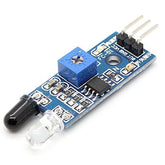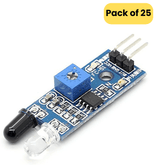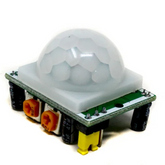Infrared Sensors: Types, Operation, and Applications
Summary
Discover the fascinating world of Infrared Sensors in our latest blog! Uncover the essence of these sensors, exploring their types, operational intricacies, and diverse applications. Delve into the mechanics behind their functioning, demystifying their role in various industries. From security systems to medical devices, we unveil the wide-ranging use cases that make Infrared Sensors indispensable. Join us on this enlightening journey as we decode the invisible spectrum, showcasing how these sensors redefine our technological landscape. Don't miss out on the future – read our blog on Infrared Sensors now!
What are infrared sensors?
Infrared sensors are a type of sophisticated technology that detect, measure and interpret infrared radiation. They use the principles of thermodynamics to improve accuracy in detecting objects by ‘seeing’ their thermal signature.
These sensors have wide-ranging applications from industrial production processes such as temperature control for machines, medical diagnosis like fever screening or cancer detection through imaging techniques to home automation systems which allow people greater convenience and safety with motion sensors activating lights when someone enters an area or alarms going off if security is breached.

Infrared sensing also enables drones to navigate outdoor settings effectively without colliding into other obstacles while they map out 3D landscapes using LiDAR technologies augmented reality apps for marketing campaigns on smartphones takes consumers deeper in immersive experiences by recognizing faces and tracking body movements accurately due its built-in high quality IR camera system giving marketers excellent insights about consumer behavior's whenever information is visualized correctly making it easier for them responded accordingly so businesses can turn data gathered more useful actions.
Explore the working principles of Infrared Sensors.
Types of infrared sensors
Pyroelectric IR sensors (PIR sensors):
Pyroelectric infrared sensors (PIRs) are energy efficient, cost-effective devices used to detect movement and alert systems when motion is detected within their range of use.

They offer a superior user experience due to their low power consumption and ability to quickly detect even the slightest movements from people or animals in large areas with minimal false alarms.
PIR sensors can be used for home security applications, intruder detection systems, perimeter protection measures, door access control systems as well as other automation solutions that require an awareness of activity around them.
As such they are uniquely suitable for ensuring safety while conserving resources – making it perfect choice for professional businesses looking achieve top tier efficiency without compromising on security standards.
Visit our Distance Sensors page for accurate sensor modules.
Phototransistor IR sensors:
Phototransistor IR sensors are an integral part of modern industry. They provide accurate and reliable measurements that enable businesses to make important decisions.

Phototransistors allow users to detect objects located on the infrared spectrum, which can be used for both sensing and tracking purposes.
Additionally, phototransistors also feature a wide operating range in terms of temperature resistance making them suitable for industrial application in extreme conditions as well as providing unique advantages over other conventional technologies such as CCDs or RFID tags when it comes to object identification accuracy and cost-effectiveness.
Phototranstors have been widely adopted across many industries given their high efficiency, reliability, durability whilst being versatile enough offer solutions tailored depending on specific use cases with minimal disruption costs involved during installation phases due this technology’s low complexity characteristics compared against more traditional alternatives available within the market.
Thermocouple IR sensors:
Thermocouple IR sensors are a reliable and accurate tool for measuring temperature in industrial applications. By combining an infrared light source with thermocouples, these sensors provide precise readings of both high and low temperatures in real-time.

The setup takes little time to configure due to their straightforward wiring, saving valuable design hours during installation.
With adjustable emissivity settings suitable for many surfaces from glass through plastics to metals, they can be used almost anywhere without external calibration or recalibration efforts required by other systems out there on the market today.
Consequently they have become one of the most popular choices among professionals needing fast results which are also cost effective too!
Bolometer IR sensors :
Bolometer IR sensors are a reliable and cost-effective method for infrared detection. They work by detecting small variations in radiation intensity, providing accurate measurements across a wide range of temperatures.
Bolometers have low noise levels, high sensitivity and fast response times — these features make them the preferred choice for many industrial applications needing to measure temperature or detect objects at long distance ranges.
For engineers looking to improve accuracy while still getting value for money on their projects, bolometers should definitely be considered as an efficient solution.
read our blog explaining the applications of ir sensor, which provides comprehensive information about the working principles of infrared (IR) sensors and their various applications.
Functioning of infrared sensors
Infrared sensors are a sophisticated piece of technology that has become increasingly important in many industries. They can detect objects from a distance without the need for physical contact, making them well-suited to high accuracy applications such as proximity sensing and location tracking.
Infrared sensors use infrared radiation emitted by an object or surface to determine how far away it is, providing reliable real-time detection up to several hundred meters away. This makes their use ideal for navigation systems like unmanned aerial vehicles (UAVs) which rely on precise direction control while moving through restricted airspace.
Moreover, they have also been used successfully in surveillance operations with impressive results due to their ability to provide accurate readings even when visibility is limited or obstructed by dust and other obstructions present in the environment.
Furthermore, industrial automation processes involving hazardous materials handling benefit greatly from IR sensor based solutions since these devices allow robot manipulators to accurately identify components at far distances leading towards greater efficiency resulting improved safety levels across critical work environments. manufacturing industry all the way into consumer electronics.
Read our blog on infrared sensors working and explore how infrared sensors work, understand how they function and the different ways we can use them, types, and the advantages and disadvantages of IR sensors.
Use cases of infrared sensors
Infrared sensors are incredibly useful in many situations. From home automation and robotics to industrial processes, these versatile infrared detectors provide an invaluable tool for professionals around the world.
Their ability to detect changes in temperature makes them ideal for controlling environmental conditions like humidity or air quality, while their non-contact nature ensures safety as well as accuracy when measuring physical parameters like surface temperatures and distances between objects.
Additionally, they can be used to monitor energy consumption of electrical devices—allowing users to quickly identify areas that could benefit from improved efficiency measures or replacement parts respectively. Infrared sensors also have great use cases within security systems; by utilizing passive infrared techniques combined with motion detection algorithms these devices act as powerful deterrents against intrusion into both residential properties and businesses alike helping preserve peace of mind through 24/7 monitoring capabilities without requiring direct contact with intruders potentially compromising employee safety protocols put in place at work environments worldwide.
Conclusion:
Infrared sensors emerge as technological marvels, bridging the unseen world into our daily lives. From thermography to motion detection, their versatile applications redefine modern sensing.
Understanding the types and operation unveils their intricate workings, paving the way for groundbreaking innovations. As we delve into diverse sectors like healthcare, security, and automation, the realm of possibilities expands. Infrared sensors, with their precision and adaptability, continue to be the unsung heroes of our interconnected world, unveiling a future where the invisible becomes an integral part of our reality. Step into the infrared frontier – where perception transcends the visible, unlocking a world of endless possibilities.
Please do check out other blog posts about Popular electronics
Make sure you check out our wide range of products and collections (we offer some exciting deals!)












